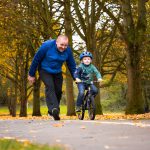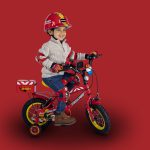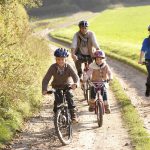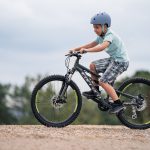If you’ve just bought your little one their first kids’ bike, then you probably have a few questions when it comes to teaching a child how to ride a bike. Mastering the skills needed to ride a bike will give them confidence and the first taste of independence.
There will be a few bumps, scrapes, and occasional tantrums while they learn to ride but, all-in-all, it’s usually one of the most exciting moments a parent and their child can experience together. If your child is ready to learn how to ride a bike (and you’re ready to teach them!), then this guide is for you. Bike helmets on and let’s get started!
Grab a bike helmet
A bike helmet is a safety essential when learning to ride a bike. As a good rule of thumb, your kid’s bike helmet should be level, with a gap of about an inch, or two fingers between the eyebrow and the helmet. The straps and adjustments should also be firm, but not so tight that it’s uncomfortable. For extra help, take a look at our advice article on finding the right size kids’ helmet.
Pick the right environment
If your child is just starting to learn how to ride a bike, they might not feel comfortable or confident riding with lots of other people around. Start your bike learning in your back garden, or find a quiet route so they can concentrate and ride without any pressure.
It may feel more natural to get them to cycle on grass first to help soften any falls, but the spongy surface can actually make it trickier for your child to grip and pedal properly. Instead, the best way to learn to ride a bike is by riding on tarmac as the harder surface will aid balance. Once they’re making good progress, you can start to explore some of our favourite traffic-free cycle routes.
If you’re concerned about your child riding on hard surfaces, we sell a range of gloves and pads to help protect them.
Focus on balance
When teaching kids how to ride, a lot of parents focus on getting pedalling right from the start. However, the biggest challenge when it comes to safely learning to ride a bike is balancing. Try doing slow rides down small hills or slopes with their feet still on the pedals to see how your child balances. Once they get this part of it right, the pedalling process should happen naturally.
For children up to four years old, a balance bike may be a better starting point. Balance bikes don’t have any pedals, so children can simply push along with their feet and then glide on two wheels to practice balancing.
Start with stabilisers
If your child is struggling to stay upright, then confidence could be a factor. This is where a pair of bike stabilisers can do the hard work while letting them focus on building confidence. Bike stabilisers simply attach onto the hub of the rear wheel and support your child’s weight on each side, so there isn’t any need to balance. Teaching a child to ride a bike with stabilisers attached can be easier, but they’ll have to learn to ride without stabilisers eventually.
A set of bike stabilisers can be attached to pretty much any kids’ bike, providing support as they figure out steering, control and pedalling. You won’t need any additional tools and they can be adjusted depending on the size and shape of the bike.
Eyes on the prize
When learning how to ride a bike for the first time, children can struggle to keep their eyes firmly focused on the path ahead as they’re drawn towards the parent trying to teach them. When learning how to ride, ask your child to look at a certain object in front and use their ears to listen to any instructions you need to give. This will help them pick up the art of balancing a lot more quickly.
Little and often
One of the most important elements to remember is to not overtire your child. Trying to master the art of learning to ride a kids’ bike isn’t always easy, so encourage them to do it for small periods of time, but on a frequent basis.
According to Cycling Weekly, it roughly takes a child around 45 minutes in total to learn to ride a bike. So try breaking every lesson into 5-10 minute periods to keep their minds’ fresh and focused. After all, you don’t want your little one to do it for a longer time and start to feel disheartened. You should always help them finish on a high as well, by reminding them about all the great progress they made during that particular session.
Get some extra help
Once your little one is whizzing around on their bike, it’s always worth thinking about a few extra lessons to keep them safe when they embark on their next two-wheeled adventure. Why not take a look to see if there are any cycling schemes for kids in your local area to help give them an extra boost?
Roadside behaviour
If your child wants to learn so that they can ride to school, it’s a good idea to teach them some easy hand-signals and safe road-side behaviour. The most used signs include extending your left arm sideways to signal left, extending it right to signal your turning right, or extending either arm sideways and bending at the elbow towards the floor (with palm facing backwards) to warn that you’re stopping or slowing.
Remind your child to always stop and listen for traffic, checking both right and left multiple times, before crossing a road. Inform them that they should also look out for hazards including driveways and bends in the road. They should only cycle on the pavement if it’s a designated cycle path and must always stop before red lights. We would advise that you should always accompany your child when they’re cycling around cars or further hazards.
Riding with gears
If your child is around the ages of 6-9, it’s probably a good time for them to familiarise themselves with bike gears. Using gears makes cycling a lot easier and helps to maintain a certain speed over different terrains and gradients.
Lower gears are great for pedalling up steeper inclines while higher gears support you on the ride back down. Typically, kids’ bikes only use rear gears and are found on the right lever. Each audible click means that the chain has changed gears.
We would suggest that your little one should cycle on a flat surface and practice changing gears. Ask them if the bike feels different to ride, depending on which gear they’re using. Remember that they should only change gears when pedalling the bike!
Learning how to ride a bike is a life lesson we don’t forget. As adults, we may have mastered the complex skills needed to ride a bike, but for some kids, it can be a challenge that may take some time. Enjoy the process and take pride in teaching a child how to ride a bike because you’re passing on to the next generation.
If you want a little added extra for your little ones’ ride, check out all our kids’ bike accessories. We have lots of choice from water bottles to spokies to baskets and much more.
Remember, if you want the best kids’ bikes and accessories, you want Halfords!




